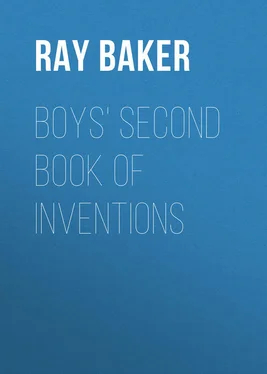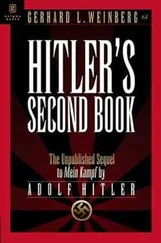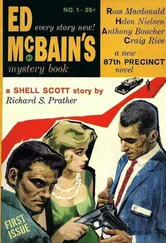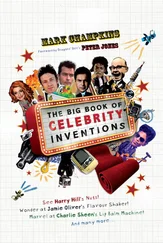Ray Baker - Boys' Second Book of Inventions
Здесь есть возможность читать онлайн «Ray Baker - Boys' Second Book of Inventions» — ознакомительный отрывок электронной книги совершенно бесплатно, а после прочтения отрывка купить полную версию. В некоторых случаях можно слушать аудио, скачать через торрент в формате fb2 и присутствует краткое содержание. Издательство: Иностранный паблик, Жанр: foreign_antique, foreign_prose, foreign_children, на английском языке. Описание произведения, (предисловие) а так же отзывы посетителей доступны на портале библиотеки ЛибКат.
- Название:Boys' Second Book of Inventions
- Автор:
- Издательство:Иностранный паблик
- Жанр:
- Год:неизвестен
- ISBN:нет данных
- Рейтинг книги:4 / 5. Голосов: 1
-
Избранное:Добавить в избранное
- Отзывы:
-
Ваша оценка:
- 80
- 1
- 2
- 3
- 4
- 5
Boys' Second Book of Inventions: краткое содержание, описание и аннотация
Предлагаем к чтению аннотацию, описание, краткое содержание или предисловие (зависит от того, что написал сам автор книги «Boys' Second Book of Inventions»). Если вы не нашли необходимую информацию о книге — напишите в комментариях, мы постараемся отыскать её.
Boys' Second Book of Inventions — читать онлайн ознакомительный отрывок
Ниже представлен текст книги, разбитый по страницам. Система сохранения места последней прочитанной страницы, позволяет с удобством читать онлайн бесплатно книгу «Boys' Second Book of Inventions», без необходимости каждый раз заново искать на чём Вы остановились. Поставьте закладку, и сможете в любой момент перейти на страницу, на которой закончили чтение.
Интервал:
Закладка:
"But in the air I have no time to fear. I have always kept a cool head. Alone in the air-ship, I am always very busy. I must not let go the rudder for a single instant. Then there is the strong joy of commanding. What does it feel like to sail in a dirigible balloon? While the wind was carrying me back to the Eiffel Tower I realised that I might be killed; but I did not feel fear. I was in no personal inconvenience. I knew my resources. I was excessively occupied. I have felt fear while in the air, yes, miserable fear joined to pain; but never in a dirigible balloon."
Even this did not daunt him. That very night he ordered a new air-ship, Santos-Dumont VI., and it was ready in twenty-two days. The new balloon had the shape of an elongated ellipsoid, 32 metres (105 feet) on its great axis, and 6 metres (20 feet) on its short axis, terminated fore and aft by cones. Its capacity was 605 cubic metres (21,362 cubic feet), giving it a lifting power of 620 kilos (1,362 pounds). Of this, 1,100 pounds were represented by keel, machinery, and his own weight, leaving a net lifting-power of 120 kilos (261 pounds).
On October 19, 1901, he made another attempt to round the Eiffel Tower, and was at last successful in winning the $20,000 prize. Following this great feat, Santos-Dumont continued his experiments at Monte Carlo, where he was wrecked over the Mediterranean Sea and escaped only by presence of mind, and he is still continuing his work.
The future of the dirigible balloon is open to debate. Santos-Dumont himself does not think there is much likelihood that it will ever have much commercial use. A balloon to carry many passengers would have to be so enormous that it could not support the machinery necessary to propel it, especially against a strong wind. But he does believe that the steerable balloon will have great importance in war time. He says:
"I have often been asked what present utility is to be expected of the dirigible balloon when it becomes thoroughly practicable. I have never pretended that its commercial possibilities could go far. The question of the air-ship in war, however, is otherwise. Mr. Hiram Maxim has declared that a flying machine in South Africa would have been worth four times its weight in gold. Henri Rochefort has said: 'The day when it is established that a man can direct an air-ship in a given direction and cause it to manœuvre as he wills … there will remain little for the nations to do but to lay down their arms.'"
But such experiments as Santos-Dumont's, whether they result immediately in producing an air-ship of practical utility in commerce or not, have great value for the facts which they are establishing as to the possibility of balloons, of motors, of light construction, of air currents, and moreover they add to the world's sum total of experiences a fine, clean sport in which men of daring and scientific knowledge show what men can do.
CHAPTER III
THE EARTHQUAKE MEASURER
Of all strange inventions, the earthquake recorder is certainly one of the most remarkable and interesting. A terrible earthquake shakes down cities in Japan, and sixteen minutes later the professor of earthquakes, in his quiet little observatory in England, measures its extent – almost, indeed, takes a picture of it. Actual waves, not unlike the waves of the sea blown up by a hurricane, have travelled through or around half the earth in this brief time; vast mountain ranges, cities, plains, and oceans have been heaved to their crests and then allowed to sink back again into their former positions. And some of these earthquake waves which sweep over the solid earth are three feet high, so that the whole of New York, perhaps, rises bodily to that height and then slides over the crest like a skiff on an ocean swell.
At first glance this seems almost too strange and wonderful to believe, and yet this is only the beginning of the wonders which the earthquake camera – or the seismograph (earthquake writer, as the scientists call it) – has been disclosing.
The earthquake professor who has worked such scientific magic is John Milne. He lives in a quaint old house in the little Isle of Wight, not far from Osborne Castle, where Queen Victoria made her home part of the year. Not long ago he was a resident of Japan and professor of seismology (the science of earthquakes) at the University of Tokio, where he made his first discoveries about earthquakes, and invented marvellously delicate machines for measuring and photographing them thousands of miles away. Professor Milne is an Englishman by birth, but, like many another of his countrymen, he has visited some of the strangest nooks and corners of the earth. He has looked for coal in Newfoundland; he has crossed the rugged hills of Iceland; he has been up and down the length of the United States; he has hunted wild pigs in Borneo; and he has been in India and China and a hundred other out-of-the-way places, to say nothing of measuring earthquakes in Japan. Professor Milne laid the foundation of his unusual career in a thorough education at King's College, London, and at the School of Mines. By fortunate chance, soon after his graduation, he met Cyrus Field, the famous American, to whom the world owes the beginnings of its present ocean cable system. He was then just twenty-one, young and raw, but plucky. He thought he was prepared for anything the world might bring him; but when Field asked him one Friday if he could sail for Newfoundland the next Tuesday, he was so taken with astonishment that he hesitated, whereupon Field leaned forward and looked at him in a way that Milne has never forgotten.
"My young friend, I suppose you have read that the world was made in six days. Now, do you mean to tell me that, if this whole world was made in six days, you can't get together the few things you need in four?"
And Milne sailed the next Tuesday to begin his lifework among the rough hills of Newfoundland. Then came an offer from the Japanese Government, and he went to the land of earthquakes, little dreaming that he would one day be the greatest authority in the world on the subject of seismic disturbances. His first experiments – and they were made as a pastime rather than a serious undertaking – were curiously simple. He set up rows of pins in a certain way, so that in falling they would give some indication as to the wave movements in the earth. He also made pendulums made of strings with weights tied at the end, and from his discoveries made with these elementary instruments, he planned earthquake-proof houses, and showed the engineers of Japan how to build bridges which would not fall down when they were shaken. So highly was his work regarded that the Japanese made him an earthquake professor at Tokio and supplied him with the means for making more extended experiments. And presently we find him producing artificial earthquakes by the score. He buried dynamite deep in the ground and exploded it by means of an electric button. The miniature earthquake thus produced was carefully measured with curious instruments of Professor Milne's invention. At first one earthquake was enough at any one time, but as the experiments continued, Professor Milne sometimes had five or six earthquakes all quaking together; and once so interested did he become that he forgot all about the destructive nature of earthquakes, and ventured too near. A ton or more of earth came crashing down around him, half burying him and smashing his instruments flat. All this made the Japanese rub their eyes with astonishment, and by and by the Emperor heard of it. Of course he was deeply interested in earthquakes, because there was no telling when one might come along and shake down his palace over his head. So he sent for Professor Milne, and, after assuring himself that these experimental earthquakes really had no serious intentions, he commanded that one be produced on the spot. So Professor Milne laid out a number of toy towns and villages and hills in the palace yard with a tremendous toy earthquake underneath. The Emperor and his gayly dressed followers stood well off to one side, and when Professor Milne gave the word the Emperor solemnly pressed a button, and watched with the greatest delight the curious way in which the toy cities were quaked to earth. And after that, this surprising Englishman, who could make earthquakes as easily as a Japanese makes a lacquered basket, was held in high esteem in Japan, and for more than twenty years he studied earthquakes and invented machines for recording them. Then he returned to his home in England, where he is at work establishing earthquake stations in various parts of the world, by means of which he expects to reduce earthquake measurement to an exact science, an accomplishment which will have the greatest practical value to the commercial interests of the world, as I shall soon explain.
Читать дальшеИнтервал:
Закладка:
Похожие книги на «Boys' Second Book of Inventions»
Представляем Вашему вниманию похожие книги на «Boys' Second Book of Inventions» списком для выбора. Мы отобрали схожую по названию и смыслу литературу в надежде предоставить читателям больше вариантов отыскать новые, интересные, ещё непрочитанные произведения.
Обсуждение, отзывы о книге «Boys' Second Book of Inventions» и просто собственные мнения читателей. Оставьте ваши комментарии, напишите, что Вы думаете о произведении, его смысле или главных героях. Укажите что конкретно понравилось, а что нет, и почему Вы так считаете.












